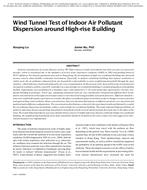Description
Airborne transmission of certain diseases such as TB (Tuberculosis) in built environments has been an issue of concern for decades, which is revitalized due to the epidemics of severe acute respiratory syndrome (SARS) in 2003 and pending threat of H1N1 influenza. For densely populated area such as Hong Kong, the development of high-rise residential buildings has attracted serious concern about healthy residential environment. Especially in modern residential buildings that natural ventilation is widely used, the air pollutant exhausted from one household could probably re-enter neighboring household through the open windows, which indicates a bad result induced by air cross-contamination. In this present work, the possible route of transmission via natural ventilative airflow caused by wind effect in a typical high-rise residential buildings is studied using physical modelling method. Experiments were performed in a boundary layer wind tunnel for a 1:30 scale model that represented a 10-story residential building in prototype. Tracer gas, simulating exhausted room air, was continuously released from different floor levels, and its concentrations on the adjacent envelope surfaces were measured using fast flame ionization detectors. Different wind directions were studied during the experiment to consider the effects on pollutant dispersion behavior due to changes in source position and approaching wind condition. Mean concentrations and concentration fluctuations at different positions were measured and analyzed under different configurations. The concentration distributions as shown by the experiment results preliminarily revealed the air pollutant dispersion mechanisms within a typical high-rise residential building. The study indicated high possibilities of airborne infectious disease spread from household to household in both vertical and horizontal directions due to the effect of the wind. The results illustrated that in case of accidental release of toxic or highly infectious diseases outbreak in high-rise residential building, the neighbouring households of an index household should be included in the close-contact list when aggressive intervention measures are implemented.
Citation: IAQ Conference: IAQ 2010: Airborne Infection Control
Product Details
- Published:
- 2011
- Number of Pages:
- 6
- File Size:
- 1 file , 440 KB
- Product Code(s):
- D-IAQ2010-C110-10




